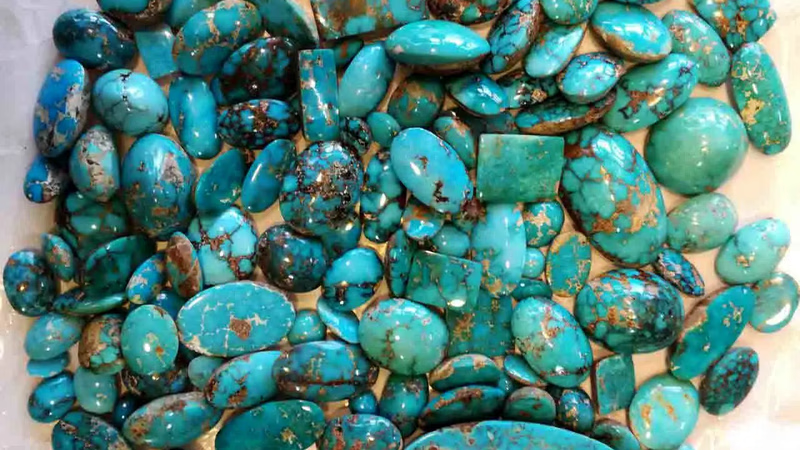
Chrysocolla and variscite: stunning alternatives to turquoise.
Chrysocolla is a gemstone that often exhibits vibrant blue and green colors, similar to turquoise. It is a hydrated copper silicate mineral and can sometimes be found in association with turquoise deposits. Chrysocolla is known for its intricate patterns, and it is often used as a substitute or complementary stone in jewelry. Variscite is a phosphate mineral that shares a similar appearance to turquoise. It can exhibit shades of green, blue-green, or yellow-green. Variscite is often found in the same geological settings as turquoise and can be mistaken for it. It is a popular gemstone used in jewelry and carvings.
Amazonite is a type of feldspar mineral that displays a distinctive blue-green or turquoise color. It has a similar appearance to certain varieties of turquoise and is sometimes referred to as "Amazon stone" or "Amazon jade." Amazonite is valued for its soothing color and is frequently used in jewelry and decorative objects. Howlite is a white or grayish mineral that is frequently dyed to resemble turquoise. Its porous nature allows it to absorb dyes effectively, resulting in vibrant blue and green colors reminiscent of turquoise. Dyed howlite is often used as an affordable alternative to turquoise in jewelry and beadwork.
African turquoise is not a true turquoise but a type of jasper or a variety of chalcedony. It features a greenish-blue color with dark matrix patterns, resembling the appearance of turquoise. African turquoise is often used in jewelry and has gained popularity as a substitute for genuine turquoise due to its unique beauty. Serpentine is a group of minerals with a wide range of colors and patterns. Some varieties, such as green serpentine or "new jade," can resemble turquoise due to their greenish-blue hues. While serpentine is not a direct substitute for turquoise, it can offer a similar aesthetic appeal in jewelry and ornamental objects.
Howlite and magnesite are light gray to white minerals that often have markings that resemble the spider webbing seen in some turquoise. They can be dyed a turquoise blue color that makes them look very similar to natural turquoise. These dyed stones fooled many people when they first entered the marketplace and still are mistaken for genuine turquoise by unfamiliar buyers. Dyed stones have damaged the market for genuine turquoise. They have been purchased with the thought that they were turquoise by many people and have produced uncertainty in the mind of many jewelry buyers. This causes some people to avoid turquoise jewelry.
A small amount of synthetic turquoise was produced by the Gilson Company in the 1980s, and some of their material was used to make jewelry. It was produced in a sky blue color, sometimes with a gray spider webbing. It was a ceramic product with a composition similar to natural turquoise. Today dyed howlite and magnesite are still used to make mass-produced beads, cabochons, tumbled stones, and other turquoise look-alike items. They are almost ubiquitous in the marketplace. Be cautious if you see turquoise with a wonderfully blue and very uniform color.
Stones similar to turquoise often have comparable mineral compositions. They may contain similar elements, such as copper, aluminum, zinc, iron, and phosphorus, which contribute to their vibrant blue and green colors. These elements, along with water molecules, form hydrated phosphate minerals that exhibit analogous hues. Many stones similar to turquoise are formed in similar geological environments. Turquoise, for example, is typically found in copper-rich areas where hydrothermal activity has occurred. The presence of certain minerals, such as copper minerals and aluminum-rich rocks, is conducive to the formation of turquoise-like minerals.
Variations in the chemical composition of minerals can lead to similarities in appearance. In the case of turquoise, iron can substitute for aluminum, and copper can replace zinc or iron within the crystal structure. These substitutions can result in slight differences in color and properties while still maintaining an overall resemblance to turquoise. Hydrothermal alteration refers to the process in which minerals are formed or modified by hot, mineral-rich fluids circulating within the Earth's crust. Stones similar to turquoise often undergo hydrothermal alteration, which can result in the formation of new minerals with comparable colors and physical properties.
-
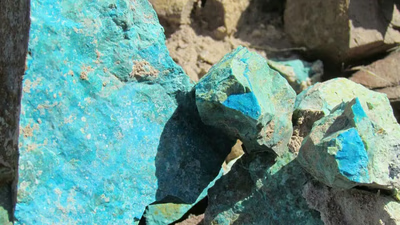
Turquoise is a gemstone with a hardness of 5 to 6 on the Mohs scale, making it relatively soft and susceptible to scratches from harder materials. Its color ranges from sky blue to greenish-blue, influenced by copper, iron, or zinc impurities. The density of turquoise varies between 2. 60 to 2. 90 g/cm³, aiding in distinguishing it from imitations. It exhibits a pale blue to greenish-blue streak and has a conchoidal fracture pattern. Weathering can alter its properties, reducing hardness and durability, often leading to its use in composite forms. Turquoise typically has a waxy to sub-vitreous luster and is generally opaque, though some polished pieces may show slight translucency.
The stone is commonly cut into cabochons or carved into various decorative shapes, showcasing its unique colors and matrix patterns that add character. The size of turquoise stones can vary significantly, impacting their application in jewelry and overall aesthetic appeal.
-

Chrysocolla, variscite, amazonite, howlite, and African turquoise are notable alternatives to genuine turquoise, each exhibiting vibrant blue and green hues. Chrysocolla is a hydrated copper silicate mineral often found alongside turquoise deposits and is prized for its intricate patterns. Variscite, a phosphate mineral, can be mistaken for turquoise due to its similar color range. Amazonite, a feldspar mineral, displays a soothing blue-green color reminiscent of turquoise. Howlite is frequently dyed to mimic turquoise"s appearance and serves as an affordable substitute in jewelry. African turquoise, while not true turquoise but rather a type of jasper or chalcedony, has gained popularity for its unique beauty. Dyed howlite and magnesite are commonly used in mass-produced jewelry but can mislead buyers into thinking they are purchasing genuine turquoise. The market has seen confusion due to these dyed stones, leading some consumers to avoid authentic turquoise altogether.
Understanding the geological formation of these minerals reveals that many share similar elements like copper and aluminum that contribute to their colors. Hydrothermal alteration processes also play a role in creating minerals with comparable properties to turquoise. Buyers should exercise caution when selecting stones that appear too uniform in color, as they may not be genuine. "
-
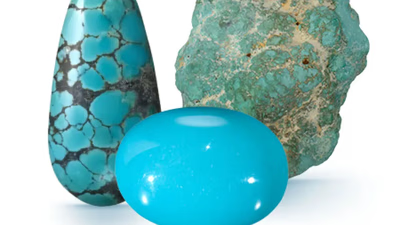
Turquoise formation is primarily linked to hydrothermal activity, where mineral-rich fluids circulate through the Earth"s crust. These fluids, rich in copper, aluminum, and phosphates, interact with host rocks like igneous and sedimentary types. The chemical reactions between the dissolved minerals and surrounding rock materials lead to the deposition of turquoise within fractures or cavities. The presence of copper is essential for turquoise"s formation, as it combines with other elements to create the mineral. Over time, geological processes such as weathering can alter its appearance and color, resulting in characteristic blue and green hues. Turquoise typically forms in arid climates and is found in regions like the southwestern United States, China, Egypt, Iran, and Mexico. Notably, the most exquisite turquoise comes from northern Iran due to its unique geological conditions. The stone often appears as an aggregate of microcrystals rather than well-formed crystals, leading to a lower porosity and higher durability.
The matrix pattern within turquoise stones varies based on the host rock material and can create unique designs. Turquoise deposits are often associated with specific geological structures that facilitate hydrothermal fluid movement, enhancing mineralization chances. Overall, understanding these processes provides valuable insights into turquoise"s formation and distribution across various regions. "
-
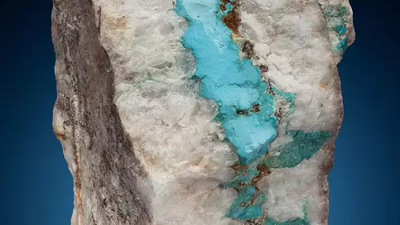
Turquoise is a color and gemstone that lies between blue and green, named after its historical ties to Turkey. This vibrant hue symbolizes calmness and emotional balance, making it popular in art, design, and fashion. The gemstone has been valued for thousands of years across various cultures, including ancient Egyptians and Native Americans, who attributed protective and healing properties to it. Turquoise is a hydrous phosphate mineral with a chemical formula of CuAl6(PO4)4(OH)8·4H2O, known for its distinctive blue-green shades influenced by copper content. It occurs in arid environments as veinlets in weathered rocks and is primarily used in jewelry-making. The stone"s popularity has led to its name being synonymous with a specific shade of blue-green in the English language. Turquoise can exhibit unique matrix patterns due to the presence of host rock or other minerals. Renowned sources include Iran, Egypt, China, Mexico, and the southwestern United States.
Each region produces stones with distinct characteristics that enhance their desirability in the jewelry market. Beyond aesthetics, turquoise carries cultural significance as a symbol of protection and good fortune across various traditions. "
-
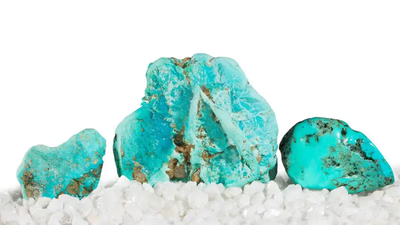
The Turquoise Group consists of minerals like turquoise, aheylite, chalcosiderite, faustite, and planerite, all sharing similar chemical compositions and crystal structures. These hydrous phosphate minerals are characterized by their vibrant blue and green colors, resulting from the presence of copper and aluminum. Misidentification is common due to their close similarities; materials sold as turquoise may actually belong to another member of the group. Accurate identification requires advanced techniques such as X-ray diffraction and spectroscopic analysis. The minerals within this group often occur together in geological settings, alongside other phosphates and silicates that can influence their appearance. Understanding these distinctions is crucial for proper classification in the marketplace, especially for verified exporters and importers in the Middle East trade platform. The historical significance of these minerals adds to their value in regional product listings and B2B marketplaces across Asia.
-
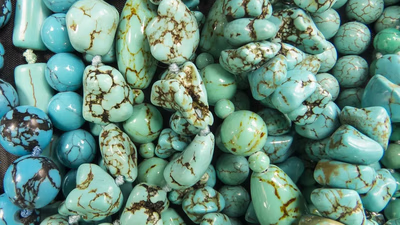
Turquoise jewelry requires careful handling and maintenance due to its sensitivity to chemicals, heat, and moisture. To preserve its color and integrity, avoid exposing turquoise to household cleaners, cosmetics, and prolonged sunlight. High temperatures can dehydrate the stone, leading to discoloration or cracking. When cleaning, use a soft cloth and mild soap; harsh methods like ultrasonic cleaners should be avoided. Proper storage is crucial—keep turquoise in a soft pouch or compartmentalized jewelry box away from direct sunlight and extreme temperatures. Turquoise"s lower hardness makes it susceptible to scratches and damage during wear, so it’s advisable to remove it during activities that may cause impact or exposure to water. The natural oils from your skin can help polish the stone when worn, but care must be taken not to let it absorb harmful liquids. If contact with damaging substances occurs, clean the stone gently with a damp cloth using mild soap followed by plain water.
Overall, treating turquoise jewelry with respect will ensure its longevity. "
-
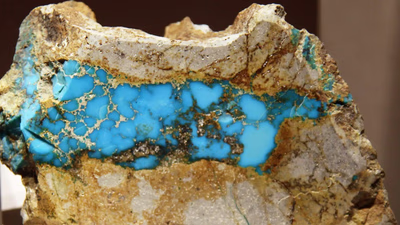
Copper is the primary element that imparts blue and green hues to turquoise, with varying amounts affecting the intensity of these colors. Higher copper content results in deeper blue tones, while increased iron can shift the color towards green. Zinc impurities can lighten the stone"s color, contributing to its bluish shades. The most sought-after turquoise colors are sky blue and robin"s-egg blue, often associated with specific geographic locations like Iraq. The geological conditions of different regions also play a crucial role in color variations, as they influence mineral compositions and elemental presence. Turquoise stones may contain inclusions from their host rock, known as matrix, which can appear as black or brown patterns within the stone. While some buyers prefer stones without matrix, others appreciate its unique designs. Notable mines such as Sleeping Beauty and Kingman produce distinct turquoise varieties characterized by their colors and matrix patterns. Additionally, water content within turquoise affects its color saturation; higher water levels typically yield more vibrant hues.







